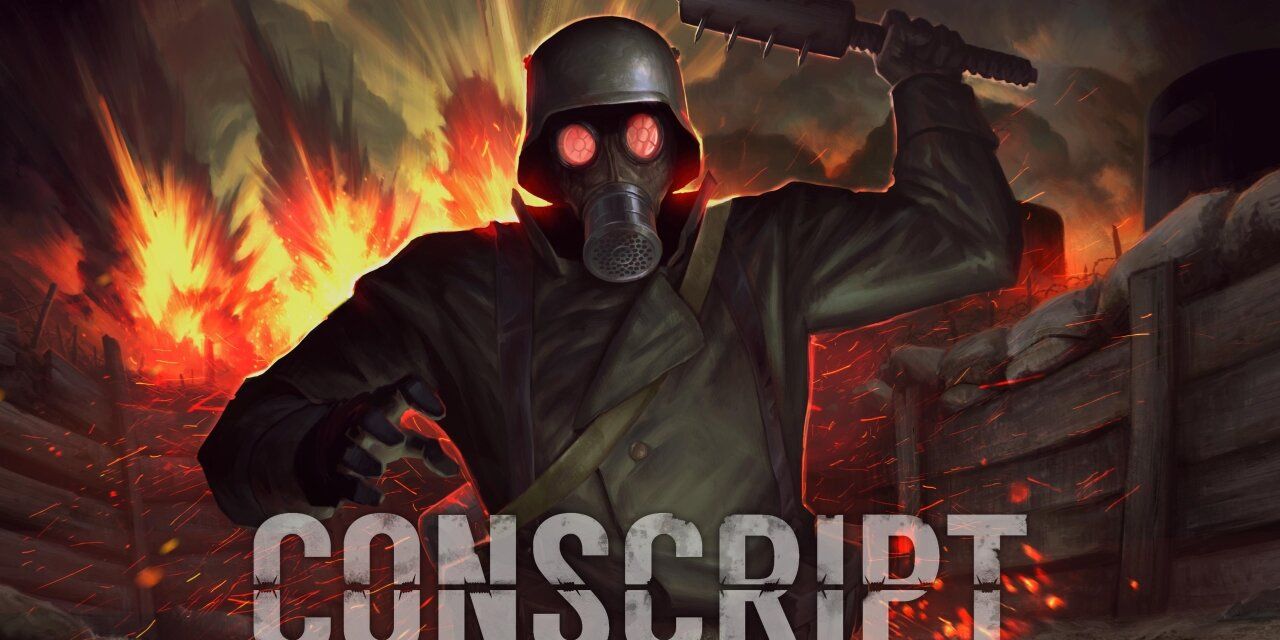“Ils ne passeront pas!”
Hailing from Melbourne, Australia is micro-indie newcomer: Jordan Mochi with his landmark survival horror title: Conscript. Having been developed under the banner of Mochi’s solo studio: Catchweight Studio for the last seven years, Conscript is a top-down, sprite-laden spiritual-sibling of classic survival horror games from the original PlayStation, Showcasing Mochi’s love for classics such as Resident Evil and Silent Hill. Featuring classic elements of the genre such as resource management, backtracking and a strong emphasis on Atmosphere, Conscript captures the soul of survival horror whilst holding down its own identity, set during the horrifying trenches of WWI in Verdun, France. Having released for all major platforms on July 23rd 2024, I’m going to be going over the time I’ve spent with the PlayStation 5 version of the game, detailing the good and deconstructing the bad, whilst ultimately concluding if the game is worth your time and money at the £21.99 asking price (UK PSN Store).
When it comes to historical settings in video games, none are quite so oppressive and bleak than those set in World War I. Primarily reserved for first person shooters like Verdun and Battlefield 1, WWI is a particular period of history that is arguably the dawn of mass-scale armed conflict that would dictate the wars to come; showcasing humanity in one of its grandest moments, but also one of it’s bleakest. Lending itself quite well to survival horror in tone, WWI is the almost-perfect backdrop for such a title, such as the excellent Ad Infinitum (2023) which showcased both the horrors of war as well as the long-term psychological effects that such trauma has on the human mind. This is what solo-developer: Jordan Mochi was aiming for whilst developing his first foray into video games with: Conscript; a survival-horror title set in the backdrop of Verdun’s trenches during WWI, taking heavy inspiration from classic survival horror titles such as Resident Evil and Silent Hill on the OG PlayStation. At its core, Conscript is a game about surviving in the trenches, resource management, and exploration. Even though it pays homage to the classics, Conscript also introduces enough modern elements to keep the gameplay feeling fresh and engaging.
Conscript places you in the shoes of a young French soldier named André, who is caught up in the brutality of the Verdun campaign during the height of WWI. Amidst the chaos of the battle, André embarks on a personal and desperate mission to find his missing brother, Pierre, who was last seen near the front lines. As André traverses the deadly and claustrophobic trench systems, he is confronted not only by the horrors of war, enemy soldiers, artillery fire, and the constant threat of death, but also by the seemingly atmospheric force that plague the battlefield. Unlike many survival horror games that rely on supernatural elements, Conscript roots its horror in the very real atrocities of war, the very bloody bone and sinew that the conflict is infamous for. It does this by grounding itself in its historical setting, immersing the player with the amount of research afforded during development; from the accuracy of the weapons and equipment to the depiction of the trenches and no man’s land, the level of detail afforded to humble art style helps create a sense of realism and believability in the game’s world. However, this realism is not purely cosmetic; the developers use the setting to heighten the horror and tension. The trenches are claustrophobic, with narrow passageways that limit visibility and movement, while the ever-present threat of enemy soldiers, gas attacks, and artillery bombardments adds to the sense of constant danger, whilst also holding down an atmosphere that could be cut with a knife.

The Fog of War: Conscript’s attention to detail and realism adds to the game’s atmosphere, which is arguably the main antagonist in the game as it chips away at André’s sanity.
In terms of gameplay, Conscript is interesting, and in more ways that one. As aforementioned, the game is heavily inspired by survival horror classics such as Resident Evil and Silent Hill, and features several mechanics and tropes that fans of either franchise will recognise instantly. Mechanics such as backtracking, resource management, exploration and on-the-fly decision making all come wrapped up together that provides a gameplay loop that feels both familiar, and wholly unique. This may be in part due to the games presentation, opting for a top-down sprite art style that (at least to me) was very reminiscent to the likes of Blood Omen: Legacy of Kain (1996) on the PlayStation. Combat is tense and deliberate, with a focus on conserving resources rather than running and gunning. The enemies are not supernatural creatures but rather enemy soldiers and the occasional wild animal, such as rats devouring corpses, which makes the combat once again feel grounded in the game’s historical setting. One of Conscript’s standout features however is its emphasis on stealth and evasion, which directly reinforces the game’s harrowing atmosphere. Ammunition is scarce, and deciding to evade enemies instead of directly engaging them can be the difference between death and survival (trench raiders suck as much in Conscript as they did in Battlefield 1). Players are often encouraged to avoid combat when possible; to make use of traps, crafted and upgraded weapons as well plan their movements ahead of exploration, all of which adds an addition layer of strategy and progression. Resource management is also key; one particular thing I liked was the decision whether to craft molotov cocktails, or to save the fuel to burn corpses, which in turn stops deadly rats from appearing that can inflict illnesses on André.
In terms of atmosphere, Conscript pulls no punches in making you feel uneasy as you traverse Verdun’s trenches. Despite opting for a pixel-art style, the simplistic aesthetics don’t detract from the experience and actually work to the game’s credit at conveying the bleakness and human horrors of WWI by utilising a muted colour palette, highlighting a sense of hopelessness within the trenches. The game’s lighting is also excellent, showcasing ambient lighting and low-light settings that both reinforce the atmosphere as well as the player’s resting heart rate, further adding to the sense of dread. The sound design in Conscript is equally impressive, with a minimalist approach that enhances the game’s tension. The ambient sounds of distant gunfire, the whistle of incoming artillery shells, and the low rumble of explosions help to create a sense of constant danger. The game also uses silence to great effect, with long stretches of quiet, broken by sudden, jarring noises that keep the player on edge. The music (when it does appear) is haunting and atmospheric, further adding to the Conscript’s oppressive mood. Conscript is a game that does a lot with very little when it comes to atmosphere; the long, drawn-out silent sections are usually the ones where the game is at it’s most tense; it uses the player’s knowledge of the war and the constant threat of death to build tension; creating a different kind of horror, one that is more rooted in the psychological.

Sosie: Much like Resident Evil, save rooms in Conscript act as a safe zone that one can take respite in away from the horrors of the outside world.
Overall, Conscript is a masterful blend of classic survival horror mechanics and a unique, historically grounded setting. The game’s emotional story, atmospheric presentation, and challenging gameplay make it a standout title in the indie horror scene; the game’s focus on the horrors of war, rather than supernatural elements, gives it a unique identity in an oversaturated genre. By grounding its horror in the real-life atrocities of World War I, Conscript creates a different kind of fear—one that is more psychological and rooted in reality. This, combined with the game’s emotional narrative, detailed pixel art, and haunting sound design, makes Conscript a memorable and impactful experience that is a treasure trove for horror and history fans alike.
A PlayStation 5 review code was provided by Team17.







